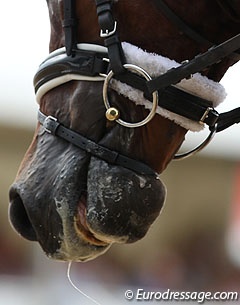
This article is a continuation of Noseband Special: Part I: The History of the Noseband
The purpose of a noseband is only secondary to finding the right fit for each horse. The selection of a noseband is tightly linked to the anatomy of the horse as the anatomical predisposition of the horse’s head co-determine one's choice in noseband.
Horse Anatomy Determines the Fitting of a Noseband
Important parts of the horse’s head for the correct fitting of nosebands are the nasal bone, the jaw, the tongue, the bars and the chewing musculature. The nasal bone and nose ridge of the horse on which every noseband rests become more delicate towards the nostrils. In 1844 German riding master Louis Seeger, who owned a training stable in East Prussia and Berlin and trained at the Spanish Riding School with von Weyrother, mentionsed in his manual “System der Reitkunst” that one has to take care how to handle the cavesson to prevent injuries “as the nasal bone is only lightly clothed by thin skin and (…) can easily be injured.”
The lower jaw consists of two similar built bone parts which run separately to unite near the top, where the incisors are located. Between the incisors and molars there is a teethless area of gum in the mouth called the bars which is the place where the bit rests. The lower jaw is not that strong that it could stand very strong pressure and it can even break when a certain amount of pressure from bits with strong leverage is put on an open jaw. The tongue of the horse is largely a muscle and fills up the mouth between the teeth. It acts as a cushion for the bit for which there is actually space in the mouth by Nature. So every bit action causes some pressure on the tongue and bars.
The biggest muscles of the horse’s head are the cheek muscles which are a part of the chewing musculature. They open and close the jaw and are also responsible for the crossing of the jaws. The horse starts to chew if the jaw is relaxed and flexible. When the chewing musculature is braced for whatever reason the neck and the back of the horse become fixed and automatically the hind legs are affected as well. Sometimes the bracing of the chewing musculature can result in the horse audibly grinding its teeth.
Unlike bones and muscles nerves remain invisible to us. However it is interesting to know that two neural strands are running in regions where we put the noseband on a horse. One big neural strand ends where the English noseband is positioned, another in the chin groove where the dropped noseband is fastened. What does this mean for the adjustment of these? Tightened too much it is likely that the nerve is compressed, causing neural pain to the horse.
In general one has to pay attention to the following:
- All nosebands have to be adjusted in a way that it doesn’t press on the nostrils or the cheek bone; the airflow must not be restricted in any way.
- Any noseband has to be fitted so you can pass 2 posed fingers resting on bony parts under the straps. The horse has to be able to still open its mouth, relax the jaw and chew, otherwise it will not come on the bit except when using force.
- Nosebands have to be chosen not entirely by purpose, but also by the horse’s individual head anatomy and have to be fitted correctly.
Choice in Nosebands: Haphazard, Fashion or Deliberate?
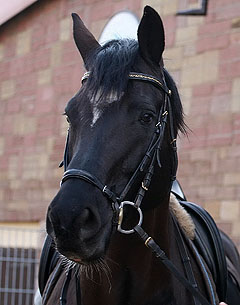 Although most of the manuals and some equestrian magazines give general overviews about the purpose of a noseband, it is surprising to notice that many riders, even top level ones, do not have a clue why their horse is wearing a noseband, let alone why they chose a certain type. Most of the snaffle bridles one sees today in European tack-shops have a flash noseband, very often with the Swedish type of buckling (crank) and that is also mainly the type used in the "normal" riding stables.
Although most of the manuals and some equestrian magazines give general overviews about the purpose of a noseband, it is surprising to notice that many riders, even top level ones, do not have a clue why their horse is wearing a noseband, let alone why they chose a certain type. Most of the snaffle bridles one sees today in European tack-shops have a flash noseband, very often with the Swedish type of buckling (crank) and that is also mainly the type used in the "normal" riding stables.
This haphazard, unconscious and often fashionable use of a noseband spurred me to do a small survey in order to get a quick impression on the variety of opinions existing about the usage of nosebands. The general opinion among the 15 riders I asked, competition and pleasure riders alike, was that a noseband is there to keep the mouth shut, some said it makes a horse look better and one pleasure rider seriously expressed that a noseband is there to prevent the bit falling out of the horse’s mouth, pointing at the additional strap of her flash.
There are also voices which suggest that riding with a noseband is abuse and that a rider with soft, quiet hands does not need a bridle with a noseband, referring to the assumption of it as a mouth-shutter. The term of a simple cavesson noseband actually is given in western riding!
However, not only pleasure or western riders consider nosebands as a dispensable piece of tack, also in dressage some think they do better without. Can we do without in dressage riding? To give a competent answer we have to look at the different purposes the usage of a noseband has, but we also have to differ between young horses learning to take the bit and older, more advanced horses.
Keeping the general dressage principle into account that the horse should be in a light, but constant contact with the rider’s hands, the chewing musculature needs to be relaxed to allow the horse to take and taste the bit by chewing. It is certain that muscles do not relax when the mouth is open, for whatever reason.
Shut the Mouth?
The popular misconception is that a noseband is only there to shut a horse’s mouth and in Germany the actual term “mouth shutter” is even used for a noseband. This is not completely wrong in different aspects. No doubt too many dressage riders use the noseband to firmly shut their horse’s mouth and thereby enabling themselves to ride with force which is necessary to control the power created by tension instead of achieving relaxation.
 To shut a horse’s mouth also seems inevitable if one wants to follow training methods in which the horse is put into unnatural positions for a long time and as a consequence begins to fight the bit to escape the uncomfortable position it is in. Is it a coincidence that the crank noseband with its ability to be tightened to extremities became highly popular in a time when some left the path of the classical approach to dressage for a more "modern" approach.
To shut a horse’s mouth also seems inevitable if one wants to follow training methods in which the horse is put into unnatural positions for a long time and as a consequence begins to fight the bit to escape the uncomfortable position it is in. Is it a coincidence that the crank noseband with its ability to be tightened to extremities became highly popular in a time when some left the path of the classical approach to dressage for a more "modern" approach.
However, no matter which training method followed -- classical or modern -- the noseband will serve as a kind of “mouth shutter” in certain circumstances. In the training of a recently broken horse the noseband plays the important part of showing the horse how to handle the pressure the right way when the bit action sets in. With a young horse it is a natural reaction that it opens the mouth or crosses the jaw too much when it feels bit pressure on the tongue or bars for the first times. The youngster tries to escape the first (soft) contact and braces the chewing musculature which should relax. By closing the mouth in an acceptable manner the young horse will more easily learn to take the bit and to chew which is only possible if the noseband is not too tight. When riding in a simple broken snaffle bit the rein aids are transported to the bars and the tongue. The horse which tries to evade the bit gets some pressure on the nose by the noseband and gives in, ideally by lowering the head. This means that the noseband, according to the type, takes over some pressure from the bit. The general rule is: the lower a noseband is positioned the more pressure is taken over. While the nose strap gives only some pressure on the sensitive nose of the horse, the chin strap supports the lower jaw. A correctly fitted noseband not only helps to show the youngster the right acceptance of the bit, but also prevents that it establishes unpleasant reactions like gaping, crossing the jaws or even putting the tongue over the bit which can happen no matter how good the rider’s hands are.
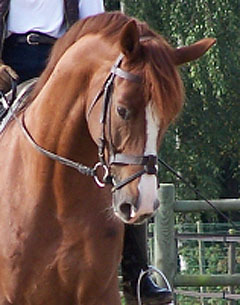 Renowned classical French dressage rider Catherine Henriquet gives an easy general tip to find the correct tightness of a noseband: "your horse still has to be able to eat a treat." Under the tutelage of her husband Michel, a long time student of legendary Nuno Oliveira, Catherine became an Olympic dressage rider strictly following the classical principles.
Renowned classical French dressage rider Catherine Henriquet gives an easy general tip to find the correct tightness of a noseband: "your horse still has to be able to eat a treat." Under the tutelage of her husband Michel, a long time student of legendary Nuno Oliveira, Catherine became an Olympic dressage rider strictly following the classical principles.
“For a young horse which feels the bit in its mouth for the first time it is a natural and immediate reaction to defend itself, for example by trying to put the tongue over the bit. This can become systematic. In some cases when horses have very sensitive mouths the jaws can cross even with a rider has soft hands. Here the usage of a noseband helps to prevent a problem before it manifestis itself. Adjusted the correct way a noseband leaves the horse enough room to chew on the bit. It has to be closed in a way that we can still give the horse a treat. Used with consideration and respect a noseband is nothing else than a simple precaution to limit the gaping. We use the dropped or flash nosebands in this spirit on our saddle broken youngsters and think it might be dispensable in 8 of 10 horses. With our more advanced horses we use the French noseband (identical to the English). However the best prevention against gaping and crossing jaws is a fine hand. A normal mouth and a fair hand is the better way to a good contact than blocking the jaws by a tight noseband. Horses which haven’t shown specific problems in the first 18 months of their training should be able to do without a noseband.”
Relax the Muscles and Spare the Mouth?
Dressage horses with totally cranked jaws and their mouths ruined by an overly strong contact from the unavoidable curb is the image the furthest away from the dressage ideal.
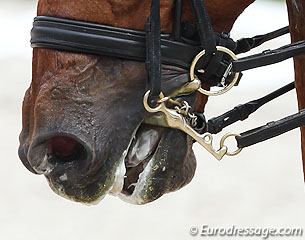 The aim has to be a relaxed, chewing horse with soft jowls, neck and back. The controversial French riding master Francois Baucher claimed that all riding problems come from the horse’s mouth and can be solved from there. Undoubtedly many problems have its origin in a braced jaw and neck muscle, but the reasons are variable. First and foremost hard, pulling hands are almost impossible to avoid when a horse wears a noseband.
The aim has to be a relaxed, chewing horse with soft jowls, neck and back. The controversial French riding master Francois Baucher claimed that all riding problems come from the horse’s mouth and can be solved from there. Undoubtedly many problems have its origin in a braced jaw and neck muscle, but the reasons are variable. First and foremost hard, pulling hands are almost impossible to avoid when a horse wears a noseband.
Presuming that a rider has soft hands and is not pulling the noseband helps to reach a relaxed mouth as it supports the chin of the horse. Without a noseband the jaw more easily opens from bit pressure. The Austrian vet Dr. Robert Stodulka mentions in his well respected book “Medizinische Reitlehre” that a noseband which is fitted neither too tight nor too deep spares the horse’s mouth and holds no danger.
Hold the Bit Straight and Quiet?
In order to give precise and soft signals with the bit the noseband has to be correctly fitted by ideally laying straight and as quiet as possible in the horse’s mouth. Ruth Klimke, mother of Germany’s highly respected dressage and eventing rider Ingrid, considers this the principle function of a noseband in the dressage training: “The bit should be quiet in the horse’s mouth so the horse feels comfortable.”
Eggbut or full cheek snaffle bits fairly fulfil this requirement simply by their construction, but also some nosebands can help keep the bit straight and quiet. It seems that in particular the flash noseband with its flash strap closing in front of the bit, but also a correctly fitted dropped noseband support the bit and help it stay quiet. This effect does not happen with other nosebands such as the half moon or the English one.
Optical Reasons?
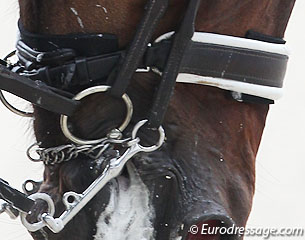 Finally a noseband can also have the purpose of influencing the look of a horse’s head. In some cultures throughout the ages nosebands are decorated with embroideries, ropes, ornaments or crystals to create a certain impression, but also nowadays nosebands with patent leather, crocodile leather, chains, pearls or crystals are very popular among competition and pleasure riders alike to distinguish their horse from the mass.
Finally a noseband can also have the purpose of influencing the look of a horse’s head. In some cultures throughout the ages nosebands are decorated with embroideries, ropes, ornaments or crystals to create a certain impression, but also nowadays nosebands with patent leather, crocodile leather, chains, pearls or crystals are very popular among competition and pleasure riders alike to distinguish their horse from the mass.
A noseband can influence an ill-proportioned head in a likeable way. Depending on the type of head and noseband the latter can shorten or lengthen a horse’s face or make broad cheeks appear thinner. Some riders do not choose the type of noseband by its function, but by its appearance which only is understandable when it comes to show classes or vet-checks.
Completely Without?
There are FEI disciplines such as reining and endurance in which we mostly see horses without nosebands, but then these are riding styles which do not need a constant bit contact and are mainly ridden with loose reins not effecting the jaw. Dressage is about having a constant, though light contact with the horse’s mouth and for this we have to impact it. Does this automatically mean a choice between gaping or a firmly closed noseband? For actively competing dressage riders this is a non-existent question because the rules require a noseband.
Amongst dressage riders outside the competition ring we can see youngsters and advanced horses alike ridden up to high level without a noseband, for example through the followers of the French Philippe Karl, a fairly controversial figure in dressage. The Frenchman created a method based on his experiences and knowledge from different riding masters, which he had patented and called “École de Légèrété” (School of Lightness).
While nosebands seem to be a useful piece of tack, at least when training young horses, they seem of no great importance in his approach. I wanted to know if there is a specific philosophy behind it and had the opportunity to talk to Swiss Corinne Daepp, a Philippe Karl student, who has been riding in one of his instructor courses for two years now and before had been training in an Olympic dressage stable winning classes up to S-level.
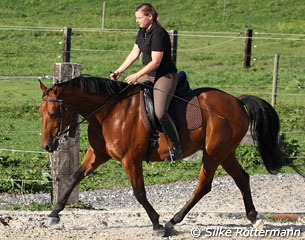 ”I prefer riding without a noseband, especially with horses which are not chewing much. By not having the restraint of a noseband they begin to play with the bit and feel more comfortable without. The horses mobilise the lower jaw in a better way, but it is necessary to ride with higher hands than usual in dressage. When the corners of the mouth are effected you put the hands down again to give in. Whenever I make an impact on the mouth I do it upwards and not backwards. The aim is that the horse mobilises the lower jaw and tastes the bit and then I put my hand down again. With advanced horses which are steady in the contact and chew I almost don’t need to raise my hands because the horse is not resisting anymore and there's no pressure on tongue and bars. A well trained horse doesn’t need a noseband. There are horses which open their mouth while chewing, even if the rider has a very soft contact. Many riders would put a tight noseband on such a horse to restrict the opening of the mouth to make it look better, but it isn’t for the horse. Leave the horse's habits like these. Badly trained horses with tongue problems or which are heavy in the hand improve if I take the noseband off their bridle. Some horses do open their mouths if I remove it, but it stops as soon as they become light on the bit. All this seems hard to achieve if you ride with deep hands because you always effect the tongue and bars and if you need to give a stronger half halt it has to be backwards and the horse opens the mouth. It’s interesting to note that some good riders seem to have mentioned this and carry their hands higher.”
”I prefer riding without a noseband, especially with horses which are not chewing much. By not having the restraint of a noseband they begin to play with the bit and feel more comfortable without. The horses mobilise the lower jaw in a better way, but it is necessary to ride with higher hands than usual in dressage. When the corners of the mouth are effected you put the hands down again to give in. Whenever I make an impact on the mouth I do it upwards and not backwards. The aim is that the horse mobilises the lower jaw and tastes the bit and then I put my hand down again. With advanced horses which are steady in the contact and chew I almost don’t need to raise my hands because the horse is not resisting anymore and there's no pressure on tongue and bars. A well trained horse doesn’t need a noseband. There are horses which open their mouth while chewing, even if the rider has a very soft contact. Many riders would put a tight noseband on such a horse to restrict the opening of the mouth to make it look better, but it isn’t for the horse. Leave the horse's habits like these. Badly trained horses with tongue problems or which are heavy in the hand improve if I take the noseband off their bridle. Some horses do open their mouths if I remove it, but it stops as soon as they become light on the bit. All this seems hard to achieve if you ride with deep hands because you always effect the tongue and bars and if you need to give a stronger half halt it has to be backwards and the horse opens the mouth. It’s interesting to note that some good riders seem to have mentioned this and carry their hands higher.”
To summarise Däpp's statement: Impacting the corners of the mouth with higher hands means less pressure than impacting the tongue and bars with lower hands? Does less pressure mean less opening of the mouth? If we reverse Mrs. Daepp’s statement it almost would mean that in the end the problem of gaping is caused by riding young horses with deep hands and we could easily avoid this with young horses which learn to chew on the bit by mainly affecting the corners of the mouth? Isn’t it the most natural reaction of a young horse to react to pressure, wherever given? And isn’t it quite logical that every more excessive opening of the jaw, no matter caused by impacting the tongue or the mouth's corners, puts strain on muscles we aim to relax. It seems to hold the danger of establishing a bad habit with young horses learning to take the bit.
There is no equivocality about whether dressage horses need to be ridden with a noseband. Instead it is more useful to differ between young and more advanced horses and especialy those with problematic mouths. Undoubtedly a noseband seems to be very useful, if not indispensable, with young horses learning to take the bit, but it appears unnecessary with well trained and well ridden dressage horses. It is not an instrument to solve serious training problems.
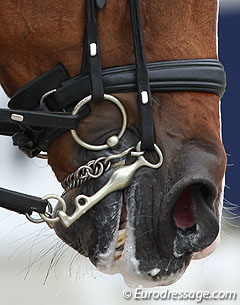 Ruth Klimke confirms this assumption: “Uta Gräf and her stallion show that a highly trained horse does not need a noseband or a bit. My daughter Ingrid rides Abraxxas (her Olympic champion in three-day-eventing) over small jumps and in tempi changes only with a neck ring.”
Ruth Klimke confirms this assumption: “Uta Gräf and her stallion show that a highly trained horse does not need a noseband or a bit. My daughter Ingrid rides Abraxxas (her Olympic champion in three-day-eventing) over small jumps and in tempi changes only with a neck ring.”
German Martin Plewa, an international eventing rider in the 1970s, the German national eventing coach for many years and today the chief of the German Riding and Driving School in Münster, also expressed in a seminar some years ago that a highly trained horse should be able to do without any noseband. Former chief rider of the Cadre Noir and FEI judge Colonel Christian Carde, like the Henriquets a representative of the French approach, is in unison with Klimke and Plewa’s and told Eurodressage: “If a rider has good hands there will be no gaping of a well trained horse, so a noseband is dispensable.”
In principle it should be. However not all horses reach this level of lightness, not even the most highly trained one. Furthermore not all riders, not even at Olympic level, have that ideal contact with the bit, nor have those soft and feeling hands which are required to get such a contact.
by Silke Rottermann for Eurodressage.com
Photos © Astrid Appels - Silke Rottermann
Continue: Noseband Special: Part III: Top Level Riders and Trainers on Their Choice in Nosebands
Related Links
ISES Suggest to Empower FEI Stewards to Control Tightness of Noseband
Noseband Special: Part I: The History of the Noseband